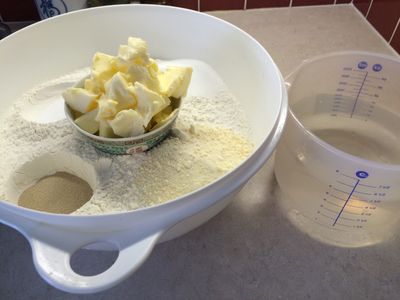
Here's everything you need. Basic ingredients: Flour, Water, Salt, Yeast and enrichments: Sugar, Milk Powder and Butter
A Few Extra Ingredients for Enriched Dough #
Classic crusty loaves like baguettes are called "lean dough" - the only ingredients are Flour, Water, Salt and Yeast.
However, for our Learning Loaf, I am adding some enrichments to the dough in the form of sugar, milk powder and butter.
These extra ingredients will make the crust and crumb nice and soft. The bread will be more like the pan breads my mom and grandmother made when I was a kid.
They were smart ladies! They were busy but still wanted to bake their own bread, so needed a dough that was easy to work with and very forgiving. For our purposes, that's a great place to start too.
Let's dig deeper into those extra ingredients:
Butter #
Butter (or any fat) in bread dough will give you a soft, golden crust and will also help your bread toast up beautifully the next day.
We use unsalted butter at the bakery so we can better control the amount of salt in a large batch of dough. If you have some unsalted butter at home, use it. If not, salted butter will do just fine.
Sugar #
Adding a small amount of sugar to the dough may make your bread slightly sweeter, but the main thing it does is give your tastebuds the feeling of moisture. When you eat a piece of moist cake, what you're really tasting is the sugar.
We do the same thing, in a smaller scale, in our learning loaf.
We use white granulated sugar in our learning loaf. Feel free to substitute with raw sugar, just be sure it dissolves fully when you mix your dough.
Milk Powder #
The proteins in milk work a lot like butter and sugar in making your bread soft and moist. I find adding milk gives me a tight crumb - no holes - which is great for a sandwich loaf.
Because I'm obsessed with dough temperature, I don't want to mess with liquid milk from the fridge. So I use powdered milk in my baking.
If you don't have milk powder, you can substitute liquid milk. Just remove 80g of water from your recipe for every 100g of milk you add.
Here's an example. If your recipe calls for 30g milk powder:
- add 30g cow's milk instead (skim, whole, or anything in between)
- reduce water by 0.8 * 30g = 24g